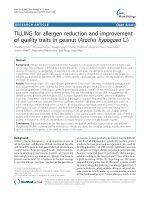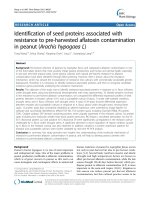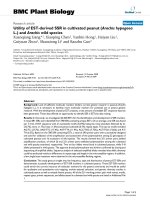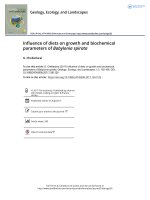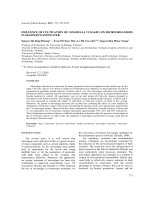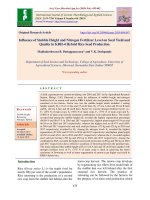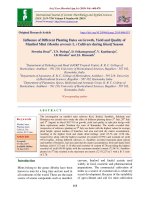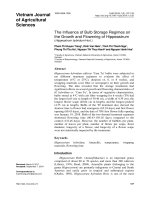Influence of gamma irradiation on microbial load of peanut (Arachis hypogaea L) Kernels
Bạn đang xem bản rút gọn của tài liệu. Xem và tải ngay bản đầy đủ của tài liệu tại đây (429.31 KB, 14 trang )
Int.J.Curr.Microbiol.App.Sci (2020) 9(8): 589-602
International Journal of Current Microbiology and Applied Sciences
ISSN: 2319-7706 Volume 9 Number 8 (2020)
Journal homepage:
Original Research Article
/>
Influence of Gamma Irradiation on Microbial Load of
Peanut (Arachis hypogaea L) Kernels
D. K. Gojiya*, S. P. Cholera and A. M. Joshi
Research Scientist, Junagadh Agricultural University, Junagdh, India
*Corresponding author
ABSTRACT
Keywords
Gamma Irradiation,
Peanut kernels,
Microbial load,
Moisture content,
D10 value
Article Info
Accepted:
10 July 2020
Available Online:
10 August 2020
The influence of gamma irradiation on microbial load of different peanut varieties has
been assessed. The healthy and mature kernels of peanut variety popular in saurastra
region of India viz. GG-20 and TG-37A were naturally contaminated and conditioned with
three initial moisture contents (6.0%, 8.5% and 11.0%), w.b. and packed in Poly Propylene
(PP) bags of 50μ thickness. These samples were irradiated with different gamma
irradiation dose (0 kGy, 2.5 kGy, 5.0 kGy, 7.5 kGy and 10.0 kGy) and stored at ambient
temperature for three months. Microbial load including total plate count, yeast and mold
count, E.coliand salmonella were determined for irradiated and non-irradiated peanut
kernels. Microbial load of both peanut varieties for tested microorganism significantly
increase in non-irradiated samples whereas irradiated samples showed decrease in
population for all the conditioned moisture content as storage time progressed. The
research data discovered that gamma irradiation dose of 7.5 kGy is the recommended dose
for complete elimination of total plate count as well as yeast and mold; whereas the 5.0
kGy is sufficient for complete killing of E. Coli.in kernels of both peanut varieties.
Salmonella was not noticed in any of the samples before irradiation and during whole
storage period. There was found no steady pattern in variation in D 10 value, for all the
tested microorganisms with respect to initial moisture in kernels of both the peanut
varieties.
persistent food safety problems facing by the
food industry. People, all over the globe are
demanding for nontoxic food as we all
become more concerned about the quality of
the food.
Introduction
Groundnut or peanut (Arachis hypogaea L.)
commonly known as poor people's nut. In
most of the emerging countries, peanut
kernels are stored as dry seeds and form a
massive serve of food; however huge
quantities of seeds are lost annually as a result
of microbial load as well as insects‟ attacks.
Presently, the inhibition of microbial
infestation in food materials is the most
Therefore, a range of preservative strategies
are used to prevent and reduce infestation of
molds and insects. Chemical fumigation with
pesticides, such as methyl bromide and
phosphine, is practiced for protection of
589
Int.J.Curr.Microbiol.App.Sci (2020) 9(8): 589-602
stored seeds from pest infestation. However,
as necessary as we believe, the excessive use
of these chemicals leads to have hostile
effects on both food and environment, related
with residues and ozone depletion. In
addition, the high cost of insecticides, nonavailability of suitable formulation of
chemical and packaging, along with the
increasing
incidence
of
insecticides
necessitate an alternative approach to post
harvest pest control.
chemical residues as well as pest and bacterial
infestation beyond approved levels.
The gamma irradiation is a physical treatment
comprising direct exposure of food to electron
or electromagnetic rays, for their long time
protection as well as upgrading of quality and
safety (Mahindru, 2005). In this process, the
isotope
cobalt-60
(60Co)
produces
electromagnetic
γ-rays
which
have
tremendous energy which swelling and break
alongside the molecules DNA chain and
preventing them from functioning normally.
Fortunately, radiation processing, which is
basically a cold process, can kill
microorganisms and insects, reduce postharvest losses, and enhance food safety and
quality (Loaharanu and Thomas, 2001).
Consequently, irradiation is increasingly
being applied to disinfest and decontaminate
foods and other products, while gaining
recognition as an effective quarantine
treatment for agricultural produce (IAEA,
2002). Besides drying, radiation is the only
alternative to cold processing for food
preservation that has a lethal effect on microorganisms (Gojiya et al., 2019). Further, it is
the novel method of food preservation
suggested for many countries.
As a result, the parasites and microorganisms
that have been affected and losing their
capabilities of reproducing themselves and
they die (Lacroix and Ouattara, 2000).
Consequently gamma irradiation provides
food safety and enhancing the shelf life of
peanut kernel due to its high effectiveness in
deactivating
pathogenic
and
spoilage
microorganisms without affecting product
quality (Ozden and Erkan, 2010).
The application of gamma radiation in food
processing has been broadly accepted and is
now legally endorsed as a safe and effective
technique for maintaining food quality safety.
Knowing the techno-economic benefits, about
100 different countries all over the globe have
cleared radiation treatments for over more
than 100 different food products.
Purpose of study
India‟s key export markets include the US,
the EU, Asian, SAARC countries and West
Asia. Although there is a solid assurance from
the Government to promote exports of fresh
and processed food products, and a strong
preparedness on part of the exporters and
farmers to export; Indian exports of food
products are getting rejections and bans in key
markets on surroundings of lack of obedience
with food safety and health standards.
Food irradiation has been recognized by key
health organization such as the American
Medical Association, Food and Agriculture
Organization (FAO), the World Health
Organization (WHO), the International
Atomic Energy Agency (IAEA) and the
Codex Alimentarius Commission, the US
Council of Agricultural Science and
Technology. Considering the above facts in
mind; research project was undertaken with
the following objectives.
Food products have met rejections and even
bans in markets such as the US, Vietnam, EU,
Saudi Arabia, Japan and Bhutan due to
disputes such as presence of more than
590
Int.J.Curr.Microbiol.App.Sci (2020) 9(8): 589-602
Materials and Methods
uniform moisture.
Sample preparations
Application of irradiation treatment
Healthy and mature kernels of peanut variety
GG-20 (Gujarat Groundnut-20) and TG-37A
(Trombay Groundnut-37A), popular in
sauratra region were procured in bulk from
peanut processing industry namely Balikrut
Peanut Industries, Junagadh (Gujarat). Since
initial moisture content of the two varieties of
peanut (GG-20 and TG-37A) kernels was
high ~11% w.b., therefor be tone packaging,
the peanut samples were dried at 50±2 °C to
attain the safe storage moisture level of ~6.0
% in a laboratory tray dryer (Gojiyaet al.,
2020). After getting initial moisture content,
the samples have been conditioned to 6.0, 8.5
and 11.0 % moisture content (w.b.) by adding
pre-determined amount of distilled water to
the fixed quantity of kernels. The following
equation was used to estimate the quantity of
distilled water to be added to the peanut
kernels (Obi et al., 2014).
The given irradiation doses in this study were
2.5, 5.0 7.5 and 10.0 kGywith an accuracy of
± 5.0 %. The absorbed dose was monitored by
Ceric- Cerous 100 X 2 ml ampoules, type
dosimeters (Kilo gray Gamma Dosimeter,
Batch No: DS-(3)10, Range 1-30 kGy, Bhaba
Atomic Research Centre (BARC), NaviMumbai). The dosimeters were calibrated to
ISO/ASTM 51205 (E) Standard Practice for
use of a Ceric-Cerous Sulfate Dosimetry
System, an "International Organization for
Standardization" approved by "American
Society for Testing and Materials standard".
Dosimeters were positioned a box in front,
middle and rear side and total dosimeters was
4 per run. Peanut samples were maintained at
20±2 °C during irradiation.
Storage of Peanuts Samples
The peanut variety GG-20 and TG-37A
samples were packed in PP bags and
irradiated with gamma irradiation @ 2.5, 5.0,
7.5 and 10.0 kGy using 60Co. After applying
gamma irradiation, Irradiated and nonirradiated (control) samples were stored at
ambient temperature.
… (1)
Where,
Q = Amount of water to be added (kg)
M = Initial weight of sample (kg)
y = Initial moisture content of the sample (%
w.b.)
x = Final (desired) moisture content of the
sample (% w.b.)
These irradiated peanut kernel samples of
both the varieties were evaluated at one
month interval during storage besides just
after irradiation, for its microbiological
characteristics viz. Total plate count (log
(CFU/g)), Yeast and mould (log (CFU/g)), E.
coli (log (CFU/g)) and Salmonella (log
(CFU/g)).
After addition of calculated amount of
distilled water, the samples were packed in
the peanut kernels sample of ~650 Grams
were packed in virgin Poly Propylene (PP)
bags of 50µ thickness having size: 260 x 200
mm and sealed by hand sealing machine
(Plastic Impulse Hand Sealer, model: POLY
SEAL-300mm. After that these samples were
stored in incubator at 25 ⁰ C for 24 h and
during the storage, the samples were stirred at
every 2 h during the day time to ensure
The radiation resistance (D10value) of the
tested microbial load (total plate count (TPC),
yeast and mold count (YMC), salmonella and
Escherichia Coli.) were determined. All the
obtained data were statistically analysed.
591
Int.J.Curr.Microbiol.App.Sci (2020) 9(8): 589-602
recommended by AOAC (2006). All
microbiological media were procured from
Hi-Media laboratories, Mumbai, India. First
of all, the media and all the glass accessories
to be used in the analysis were sterilized by
autoclaving at 121 °C for 20 min. The peanut
sample was diluted to 1:10 (peanut: distilled
water) and was thoroughly shaken for 10-15
min to obtain homogenized suspension of
micro-organisms. For preparation of 1:100
dilution, the 1 ml sample from 1:10 dilution
was taken with the help of pipette and 9 ml
distilled water was added into the prepared
solution. The process was repeated up to
1:1000 dilutions with the distilled water. The
test tubes containing the diluted samples were
immediately closed by cotton plugging. The
whole procedure for sample preparation was
carried out in laminar air flow (Nova
Instruments Pvt. Ltd., Ahmedabad) under
aseptic condition.
Statistical Analysis
By using factorial complete randomized
design (F-CRD) with 15 treatment
combinations (3 moisture levels X 5
irradiation doses level) were obtained for each
variety of peanut. Treatments having 0.0 kGy
gamma irradiation dose (no irradiation)
served as control for each variety and each
moisture content level. All the 30 treatments
were examined for all the biochemical,
microbiological as well as sensory evaluation
of the sample. The mean values generated
from the analysis of each of quality attributes
obtained from three replications during the
research were subjected to statistical analysis
using factorial completely randomized design
(F-CRD) and Microsoft Excel as per the
procedure suggested by Panse and Sukhatme
(1985).
Natural microbial contamination
Radiation-decimal reduction dose (D10value)
Natural microbial inoculation of peanut
kernels was most commonly achieved by
submersion in aqueous spore suspensions
(Prado
et
al.,
1999).
100
gram
microbiologically contaminated peanut seed
were grinded and submerged in 1 liter
distilled water. Filtrates of this solution add
into distilled water and mixed thoroughly
with peanut sample and shake it at low speed
until all of the added water was uniformly
absorbed to final moisture content of 11 %
(w.b). These contaminated peanut samples
incubated at 35±2 °C temperature and 80%
relative humidity in incubator for seven days.
Samples were analyzed for microbial load
after 7 days storage and used for further
experiments.
The radiation resistance (D10-value) of the
tested microbial load (Total plate count
(TPC), Yeast and mold count (YMC),
Salmonella and Escherichia Coli.) were
determined as follow. D10 value for each
tested microbial load was determined for each
radiation dose as per standard method
suggested by Khalek (2008). The number of
viable cells after radiation was divided with
the initial viable cell number. For all the
strains, survival curves relating to log
(survival) were obtained with irradiation dose.
Finally, the D10 values or the doses which can
reduce the microbial population by 90% were
calculated by using the equation
… (2)
Determination
of
Microbiological
Characteristics of Peanut Kernels
Where,
The microbiological characteristic of peanut
was carried out according to standard method
D is the radiation dose,
592
Int.J.Curr.Microbiol.App.Sci (2020) 9(8): 589-602
No is the untreated bioburden, and
N is the irradiated bioburden.
microbial population reduced due to gamma
irradiation it could not be revived again
during the subsequent storage period of three
month.
Graphically D10 values were calculated by
using Excel's linear regression analysis based
on the linearity of the survivor curves in
which D10 values were taken as the negative
reciprocal of the slope of the regression
line from dose-response curve, which was
constructed by plotting log survival counts
against irradiation doses.
For TG-37A variety, as irradiation dose was
amplified from 0.0 to 10.0 kGy, the Total
plate count (TPC) in TG-37A peanut kernels
sharply reduced from peanut 5.89 log
(CFU/g) to < 1 log, 6.73 log (CFU/g) to <1
log and 6.53 log (CFU/g) to <1 log for the
kernels with initial moisture content of 6, 8.5
and 11 % (w.b.), respectively. It was also
reported that the reduction in Total plate
count due to gamma irradiation it could not be
recovered again during the subsequent storage
period. These findings were in accordance
with results noted by Farkas (1983) for (garlic
powder, cumin, coriander, turmeric and
rosemary), Sharma et al., (1989), Hammadet
al., (1987) and El-Zawahry et al., (1985) for
different spices and its storage. Hilmy and
Suryasaputra, (1981) also reported similar
results that the microbes‟ populations
decreased as much as 2-3 log cycles after
irradiation with 5 kGy in medicinal herbs.
After 6 months of storage, microbial load of
irradiated samples further decreased and in
the case of microorganisms that survive
during irradiation treatment may be more
sensitive to environmental conditions.
Results and Discussion
Effect of Gamma Irradiation on Total plate
count (TPC) of Peanut Kernels
Total bacterial count is widely used as an
indication of the microbiological quality of
food. It can be observed that Total plate count
of tested microorganism increases in nonirradiated samples whereas, irradiated
samples showed decrease in population as
storage
time
progressed.
Irradiation
treatments induced ionization for the cell of
bacteria and direct effects on DNA of nucleus
cells (Shea et al., 2000; Temur and Tiryaki,
2013) resulting in death of cell complete
elimination was observed at and above the
irradiation dose of 7.5 kGy. As gamma
irradiation dose was enlarged from 0.0 to 10.0
kGy, Total plate count of the peanut kernels
reduced significantly. This was true for both
peanut kernels varieties and at all the three
moisture contents. These results indicate that
the higher doses of gamma radiation have
vigorously effect on Total plate count.
The statistical interpretation of Total plate
count of both peanut variety were presented in
the Table 1 indicated that during entire
storage of GG-20 and TG-37A peanut
kernels, the individual effect of gamma
irradiation dose (D) and its interaction effect
with peanut kernels initial moisture content
(D X M) had statistically significant
difference at 5% level of significance. The
individual effect of initial moisture content
(M) had found significant (P<0.05) in GG-20
whereas in TG-37A it noted non-significant
(P≥0.05) during entire storage.
At zero time after irradiation, it was noted as
dose was increased from 0.0 to 10.0 kGy, the
Total plate count (TPC) in GG-20 peanut
kernels severely reduced from 5.81 log
(CFU/g) to <1 log (CFU/g) and 6.72 to 7.72
log (CFU/g) to <1 log for the kernels with
ini����������������������������������������������������������������������������������������������������������������������������������������������������������������������������������������������������������������������������������������������������������������������������������������������������������������������������������������������������������������������������������������������������������������������������������������������������������������������������������������������������������������������������������������������������������������������������������������������������������������������������������������������������������������������������������������������������������������������������������������������������������������������������������������������������������������������������������������������������������������������������������������������������������������������������������������������������������������������������������������������������������������������������������������������������������������������������������������������������������������������������������������������������������������������������������������������������������������������������������������������������������������������������������������������������������������������������������������������������������������������������������������������������������������������������������������������������������������������������������������������������������������������������������������������������������������������������������������������������������������������������������������������������������������������������������������������������������������������������������������������������������������������������������������������������������������������������������������������������������������������������������������������������������������������������������������������������������������������������������������������������������������������������������������������������������������������������������������������������������������������������������������������������������������������������������������������������������������������������������������������������������������������������������������������������������������������������������������������������������������������������������������������������������������������������������������������������������������������������������������������������������������������������������������������������������������������������������������������������������������������������������������������������������������������������������������������������������������������������������������������������������������������������������������������������������������������������������������������������������������������������������������������������������������������������������������������������������������������������������������������������������������������������������������������������������������������������������������������������������������������������������������������������������������������������������������������������������������������������������������������������������������������������������������������������������������������������������������������������������������������������������������������������������������������������������������������������������������������������������������������������������������������������������������������������������������������������������������������������������������������������������������������������������������������������������������������������������������������������������������������������������������������������������������������������������������������������������������������������������������������������������������������������������������������������������������������������������������������������������������������������������������������������������������������������������������������������������������������������������������������������������������������������������������������������������������������������������������������������������������������������������������
5.28
10.87
10.78
13.04
10.78
Moisture Content (M)
Interaction (D x M)
596
Int.J.Curr.Microbiol.App.Sci (2020) 9(8): 589-602
Table.4 Effect of gamma irradiation on Salmonella (log (CFU/g)) in peanut kernels conditioned at different initial moisture content
during storage
Effect
0 month
(Initial value)
(1)
(2)
Gamma radiation doses (D)
D1 (0 kGy)
Absent
D2 (2.5 kGy)
Absent
D3 (5.0 kGy)
Absent
D4 (7.5 kGy)
Absent
D5 (10 kGy)
Absent
S.Em ±
CD at 5%
Moisture Content (M)
M1 (6.0 %, w.b)
Absent
M1 (8.5 %, w.b)
Absent
M1 (11.0 %, w.b)
Absent
S.Em ±
CD at 5%
Interaction (D x M)
S.Em ±
CD at 5%
C.V.%
GG-20
Storage period (month)
1st month
2nd month
3rd month
(3)
(4)
(5)
0 month
(Initial value)
(6)
Absent
Absent
Absent
Absent
Absent
-
Absent
Absent
Absent
Absent
Absent
-
Absent
Absent
Absent
Absent
Absent
-
Absent
Absent
Absent
-
Absent
Absent
Absent
-
-
-
597
TG-37A
Storage period (month)
1st month 2nd month
3rd month
(7)
(8)
(9)
Absent
Absent
Absent
Absent
Absent
-
Absent
Absent
Absent
Absent
Absent
-
Absent
Absent
Absent
Absent
Absent
-
Absent
Absent
Absent
Absent
Absent
-
Absent
Absent
Absent
-
Absent
Absent
Absent
-
Absent
Absent
Absent
-
Absent
Absent
Absent
-
Absent
Absent
Absent
-
-
-
-
-
-
Int.J.Curr.Microbiol.App.Sci (2020) 9(8): 589-602
Table.5 Radiation-decimal reduction dose (D10-value)
SSr.
No
(1)
11
Microbial Parameter,
(log CFU/g)
(2)
Total Plate Count
22
Yeast and Mold Count
3
E. Coli.
Moisture content,
w.b (%)
(3)
M1=6.0 %
M2=8.5 %
M3=11 %
M1=6.0 %
M2=8.5 %
M3=11 %
M1=6.0 %
M2=8.5 %
M3=11 %
D10 values in kGy
GG-20
TG-37A
(4)
(5)
0.83
1.09
0.97
1.02
1.26
1.09
1.21
1.07
1.06
0.96
1.57
0.92
2.18
4.40
2.19
3.84
2.61
3.11
It was noted that on initial day after gamma
irradiation, as dose increased from 0.0 to 10.0
kGy, Yeast and mold counts in GG-20 peanut
kernels significantly (P<0.05) declined from
5.95 to <1 log (CFU/g), 6.18 to <1 log
(CFU/g) and 7.26 to <1 log (CFU/g) for the
kernels with initial moisture content of 6, 8.5
and 11 % (w.b.), respectively.
It was also noticed that, Yeast and mold
counts in TG-37A peanut kernels significantly
decrease from 5.95 to <1 log 7.09 (CFU/g),
6.18 to <1 log (CFU/g) and 7.26 to <1 log
(CFU/g) with increase in gamma irradiation
dose level 0, 2.5, 5.0, 7.5 and 10.0 kGy at
different initial moisture content (6.0 to 11 %
(w.b.)). The maximum rise in yeast and mold
counts was found in the treatment F2D1M3
(7.45 log (CFU/g)) followed by F2D1M2
((6.96 log (CFU/g)) and F2D1M1 (6.31 log
(CFU/g)) samples after three month of storage
(Table 2). The similar results were reported
by Silberstein et al., (1979) for onion powder,
Farkas (1983) and Sharma et al., (1984) for
spices, Ramamurthy et al., (2004) for
capsicum, Yun et al., (2012) for soybeans
(Glycine max L. Merrill) and Ashtariet al.,
(2019) for pomegranate cv. Malas-e-Saveh
that gamma irradiation significantly reduced
the population of bacteria, fungi and yeasts in
all this product.
The data shows that the reduction in yeast and
mold counts could not be recovered again
during the consequent storage period. Yeast
and mold reportedmaximum in the treatment
F1D1M3 (7.81 log (CFU/g)) followed by
F1D1M2 ((7.44 log (CFU/g)) and F1D1M1
(7.09 log (CFU/g)) after three month of
storage.
The statistical analysis of Yeast and mold
counts of both peanut variety were the
indicated that during entire storage of GG-20
and TG-37A peanut kernels, the individual
effect of gamma irradiation dose (D) and its
interaction effect with peanut kernels‟ initial
moisture content (D X M) had statistically
significant difference at 5% level of
Effect of Gamma Irradiation on Yeast and
mold counts of Peanut Kernels
The results pertaining to effect of gamma
irradiation dose on Yeast and mold counts of
both peanut varieties at different initial
moisture content during whole storage period
reported in Table 2. It can be evidently seen
from data that Yeast and mold count decrease
with increase in gamma irradiation dose, at
and above 7.5 kGy gamma irradiation dose,
Yeast and mold in both the peanut kernels
varieties reduced below 1 log (CFU/g).
598
Int.J.Curr.Microbiol.App.Sci (2020) 9(8): 589-602
significance. The individual effect of initial
moisture content (M) had found significant
(P<0.05) in GG-20 peanut kernels while in
TG-37A it noted non-significant (P≥0.05)
during entire storage.
contaminated coconut, Singh et al., (1988) in
spices (Turmeric, black pepper, chilli),
Swailam and Abdullah (2002) for spices and
herbs found same results.
The statistical interpretation of noted
E.colidata of both peanut varieties was
presented in the Table 3. It indicates that the
individual effect of initial moisture content
(M) and gamma irradiation dose levels (D)
giving significant values (P<0.05) while its
interaction effect (D X M) also found
statistically significant at 5% level of
significance for both peanut variety during
entire storage periods.
Escherichia coli (E. coli)
The Escherichia coli (E.coli) of both peanut
varieties irradiated with different doses level
and different initial moisture content and
stored for three month period are reported in
Table 3. It can be observed from data that
E.coli decrease with increase in gamma
irradiation dose and at and above gamma
irradiation dose 5.0 kGy, E.coliin both the
peanut kernels varieties reduced below 1 log
(CFU/g).
Salmonella
The Salmonella in both peanut varieties
irradiated with different gamma irradiation
doses with different initial moisture content,
packed in poly propylene bag (PP) and stored
at room temperature for three month storage
was not noticed in any of the samples during
whole storage period.
During initial day of storage it was noticed
that as gamma irradiation dose increased from
0.0 to 10.0 kGy, E.coli in GG-20 peanut
kernels significantly decline from 2.23 to <1
log (CFU/g), 2.25 to <1 log (CFU/g) and 2.38
to <1 log (CFU/g) for the kernels having
initial moisture content of 6, 8.5 and 11 %
(w.b.), respectively. The maximum survival
of E.coli was found in the treatment F1D1M3
(2.32 log (CFU/g)) followed by F1D1M2
(2.25 log (CFU/g)) and F1D1M1 (2.23 log
(CFU/g)) after three month of storage.
It was noted, as gamma irradiation dose was
increased from 0.0 to 10.0 kGy, E.coli in TG37A peanut kernels significantly reduced
from 1.91 to <1 log (CFU/g), 2.07 to <1 log
(CFU/g) and 2.28 to <1 log (CFU/g) for the
kernels having initial moisture content of 6,
8.5 and 11 % (w.b.), respectively. The end of
three month storage, the maximum survival of
E.coli was reported in non- irradiated
treatment F2D1M3 (2.27 log (CFU/g))
followed by F2D1M2 (2.06 log (CFU/g)) and
F2D1M1 (2.27 log (CFU/g)).
Radiation-decimal reduction dose (D10value)
Microorganisms vary significantly in their
resistance to gamma radiation and differences
in radiation resistances from species to
another and even among strains of the same
species with different in condition. The
microorganism‟s resistance against radiation
is measured in terms of decimal reduction
dose (D10-value). D10-value can be defined, as
the radiation dose (kGy) essential for killing
90 % of the load of a microbe (Ingram and
Roberts, 1980). Therefore, D10-values of
potentially microbial load (Total plate count
(TPC), yeast and mold count (YMC) and
Escherichia Coli.) in peanut kernels varieties
namely GG-20 and TG-37A at three different
(6.0, 8.5 and 11 %, w.b) initial moisture
content were determined. D10-value of a
These results are in agreement with previous
findings of Farkas (1988) for artificially
599
Int.J.Curr.Microbiol.App.Sci (2020) 9(8): 589-602
microbe can be determined from dose
response curve of the microbe, which is
obtained by plotting the number of surviving
cells against radiation dose (kGy). The effect
of increment doses of gamma irradiation on
the Total plate count (TPC), Yeast and mold
count (YMC) and Escherichia Coli. noted in
Table 4.
microorganisms and its level in a product
(food, feed, medicinal or pharmaceutical
products) one can calculate the exact
irradiation dose required to eliminate that
microorganisms from that product.
Many researchers have reported the similar
variations in radio sensitivity of different
microbial species. Generally spore-forming
bacteria are more resistant (Aziz and Moussa,
2004). Relatively similar result also reported
by Hammad and El-Bazza (1988) and Thayer
and Boyd (1993) in D10-value of Escherichia
coli isolated from dry foods. Youssef et al.,
(1999) also observed complete inhibition of
fungi by gamma irradiation doses from 4 to 6
kGy in different food and feed products. It
can be said that irradiation dose of about 7.2
kGy (considering max D10 value 1.2 kGy)
required for the acceptable 6 (six) log
reductions of the microbial load. Al-Bachiret
al., (2004) reported D10 value of total count
was about 1.4 kGy in licorice root products.
From the radiation survival curves; it was
found that the D10 value (calculated from
linear regression and equation) of E. coli (it
had the highest radiation resistant among
other tested microorganism) was 4.40 kGy,
4.40 kGy and 3.84 kGy in TG-37A and 2.18
kGy, 2.19 kGy and 2.61 kGy in GG-20 peanut
kernels at 6, 8.5 and 11 %, w.b moisture
content respectively. The D10 value of Total
plate count in GG-20 was noted 0.83 kGy,
0.97 kGy and 1.26 kGy, while in TG-37A
peanut kernels it was found 1.09 kGy, 1.02
kGy and 1.09 kGy at 6, 8.5 and 11 %, w.b
moisture content respectively. In case of GG20 peanut kernels, D10 value of yeast and
mold count was revealed 1.21 kGy, 1.06 kGy
and 1.57 kGy whereas it observed 1.07 kGy,
0.96 kGy and 0.92 kGy in TG-37A kernels at
6, 8.5 and 11 %, w.b moisture content
respectively. There were no steady patterns of
D10 values change with respect to initial
moisture were observed in both peanut
varieties.
In conclusion the research data discovered
from this research suggest that the gamma
irradiation is proficient technology to control
microbial load including total plate count,
yeast and mold count, E.coli with respect to
initial moisture of peanut kernels. The report
also advocates that the gamma irradiation can
control the microbial load of both the varieties
of peanut kernels, just after irradiation and
during storage. Gamma irradiation dose of 7.5
kGy is the sufficient dose for complete
elimination of total plate count as well as
yeast and mold; whereas the 5.0 kGy is
sufficient for complete killing of E. Coli.in
kernels of both peanut varieties.
Knowledge of the D10-value of different
microorganisms from survival curves (doseresponse curves) is very needful in calculating
the lethal and sub-lethal dose of
microorganisms. It is also useful in providing
information about the relative resistance of
particular microorganisms to ionizing
radiation and calculating the exact radiation
dose required for 5-log cycle's reduction of
pathogenic
bacteria
and
mycotoxin
production fungi, which is very important for
the practical application of ionizing radiation.
By knowing the D10-value of any
Acknowledgments
The authors would like to thank Prof. D. M.
Vyas and The Junagadh Agricultural
University for cooperation and provided
necessary facilities to achieve the desired
goals of this research.
600
Int.J.Curr.Microbiol.App.Sci (2020) 9(8): 589-602
Studies.7 (5): 1429-1434.
Hammad, A. I. and El-Bazza, Z. E. 1988. Molds
contaminating smoked herring and their
control by gamma irradiation. Al- Azhar J.
Microbiolo. 4:10-23.
Hammad, A. I., Abd El-Aal, S. S. and El-Rify,
N. 1987. Radiation decontamination of
some important spices from its bacterial
load. Egyptian Journal of Applied
Science.3(1): 273-281.
Hilmy, N., and Suryasaputra, C. 1981.
Radiopasteurization of traditional herbal
medicine. Majalah BATAN. 14(1): 41-58.
IAEA. 2002 b. Study of the impact of food
irradiation
on
preventing
losses:
Experience in Africa. International
Atomic Energy Agency TECDOC-1291,
Proc. RCM, Pretoria, RSA.
Khalek h. h. A. 2008. Effect of γ-irradiation on
the microbial, chemical quality and the
biological activity of some spices and
herbs. Ph. D. Thesis (Unpublished).
Department of Food Science, Faculty of
Agriculture, Cairo University, EGYPT.
Lacroix, M. and Ouattara, B. 2000. Combined
industrial processes with irradiation to
assure innocuity and preservation of food
products - a review. Food Research
International. 33(9): 719-724.
Loaharanu, P. and Thomas, P. 2001. Irradiation
for food safety and quality. Proc.
FAO/IAEA/WHO, Turkey. Technomic
Publishing Co. Inc.
Mahindru, S. N. 2005. Food preservation and
irradiation. Aph Publishing Corporation.
Chapter-8, p. 13.
Nagar, V. and Bandekar, J. R. 2011.
Effectiveness of radiation processing in
elimination of Aeromonas from food.
Radiation Physics and Chemistry. 80(8):
911–916.
Obi, O. F., Anyadike, C. C. and Onyeke, C. O.
2014. Moisturedependent mechanical
properties of pigeon pea grown in Nigeria.
International
Journal
of
Science,
Environment and Technology. 3(3): 966975.
Ozden, O. and Erkan, N. 2010. Impacts of
gamma
radiation
on
nutritional
References
Al-Bachir, M. 2004. Effect of gamma
irradiation on fungal load, chemical and
sensory characteristics of walnuts
(Juglans regia L.). Journal of Stored
Products Research. 40(4): 355-362.
AOAC. 2006. “Official Methods of Analysis”.
Association of Official Analytical
Chemists. Washington, USA.
Ashtari, M., Orang, K., Mahmoud, S., Hamideh,
A. and Mohammad, A. A. S. 2019. Effect
of gamma irradiation on antioxidants,
microbiological properties and shelf life
of
pomegranate
arils
cv.
„MalasSavehʼ. Scientia
Horticulturae.
244(1): 365-371.
Aziz, N. H. and Moussa, L. A. A. 2004.
Reduction of fungal and mycotoxins
formation in seeds by gamma radiation.
Ph. D. Thesis (Unpublished). Faculty of
Science, Ain Shams University, Egypt.
Dionisio, A. P., Gomes, R. T. and Oetterer, M.
2009. Ionizing radiation effects on food
vitamins – a review. Brazilian Archives of
Biology and Technology. 52(5): 1267–
1278.
El-Zawahry, Y. A., Youssef, Y. A., Awny, N.
M. and Hussein, H. A. 1985. Bacterial
flora of spices and its control by gamma
irradiation. Egyptian Journal of Radiation
Sciences and Applications. 2(1): 57-68.
Farkas, J. (Ed.). 1988. Irradiation of dry food
ingredients. CRC Press, Boca Raton, FL.
Farkas, J. 1983. Radurization and radicidation
of spices. In: Josephson, E.S. and
Peterson, M.S.: Preservation of food by
ionizing radiation. CRC Press, Inc. Boca
Raton, V. III, pp. 109-128.
Gojiya, D.K., 2020. Studies on Physical and
Engineering Characteristics of Peanut
Kernel. India. Int J NutrSci& Food
Tech, 6:2-22.
Gojiya, DK, Naliapara, VA and Vyas, DM.
2019. Studies on effect of gamma
irradiation on biochemical characteristics
of peanut kernels (Arachis hypogaea L.).
International Journal of Chemical
601
Int.J.Curr.Microbiol.App.Sci (2020) 9(8): 589-602
components of minimal processed
cultured sea bass (Dicentrarchuslabrax).
Iranian Journal of Fisheries Sciences.
9(2): 265-278.
Panse, V. G. and Sukhatme, P. V. 1985.
Statistical methods for agricultural
workers. ICAR, New Delhi, p. 361.
Prado, G., Oliveira, M. S., Gazzinelli-Madeira,
J. E. C., Godoy, I. J., Correa, B.,
Junqueira, R. G. and Ferreira, S. O. 1999.
Resistance of aflatoxin B1 production by
Aspergillusflavus Link its inoculation
onto four peanuts genotypes. Food
Science and Technology, 19(1): 84-87.
Ramamurthy, M. S., Kamat, A., Kakatkar, A.,
Ghadge, N., Bhushan, B. and Alur, M.
2004. Improvement of shelf-life and
microbiological quality of minimally
processed refrigerated capsicum by
gamma irradiation. International Journal
of Food Sciences and Nutrition. 55(4):
291-299.
Sharma, A. K. and Sharma, K. D. 1984.
Changes in free fatty acids during fungal
deterioration
of
fennel
(Foeniculumvulgare
Mill.)
fruits.
Phytopathologia Mediterranea. 23(1): 8182.
Sharma, A., Padwal‐ Desai, S. R. and Nair, P.
M. 1989. Assessment of microbiological
quality of some gamma irradiated Indian
spices. Journal of Food Science. 54(2):
489-490.
Shea, K. M. and Committee on Environmental
Health. 2000. Technical report: irradiation
of food. Pediatrics. 106(6): 1505-1510.
Sheppard, A. J., and Rudolf, T. S. 1991.
Analysis of peanuts and peanut products
for total lipids, fatty acids and proximates.
Peanut science. 18(1): 51-54.
Silberstein, O., Galetto, W. and Henzi, W.
1979. Irradiation of onion powder: effect
on microbiology. Journal of Food
Science. 44(1): 975-981.
Singh, L., Mohan, M. S. and Padwal-Desai, S.
R. 1988. The use of gamma irradiation for
improving microbiological qualities of
spices. Journal of Food Science and
Technology India. 25(1): 357-60.
Swailam, H. M. and Abdullah, M. I. 2002.
Radiation sterilization of some spices and
medicinal
plant.
Egyptian Journal
of Microbiology. 2: 70-87.
Temur, C. and Osman, T. 2013. Irradiation
alone or combined with other alternative
treatments to control postharvest diseases.
African
Journal
of
Agricultural
Research. 8(5): 421-434.
Thayer, D.W. and Boyd, G. L. E. N. N. 1993.
Elimination of Escherichia coli O157: H7
in meats by gamma irradiation. Appl.
Environ. Microbiol. 59(4): 1030-1034.
Youssef, B. M., Mahrous, S. R. and Aziz, N. H.
1999. Effect of gamma irradiation on
aflatoxin B1 production by Aspergillus
flavus in ground beef stored at 5C.
Journal of food safety. 19(4): 231-239.
Yun, J., Li, X., Fan, X., Tang, Y., Xiao, Y. and
Wan, S. 2012. Effect of gamma
irradiation
on
microbial
load,
physicochemical
and
sensory
characteristics of soybeans (Glycine max
L. Merrill). Radiation Physics and
Chemistry. 81(8): 1198-1202.
How to cite this article:
Gojiya, D. K., S. P. Cholera and Joshi, A. M. 2020. Influence of Gamma Irradiation on
Microbial Load of Peanut (Arachis hypogaea L) Kernels. Int.J.Curr.Microbiol.App.Sci. 9(08):
589-602. doi: />
602
